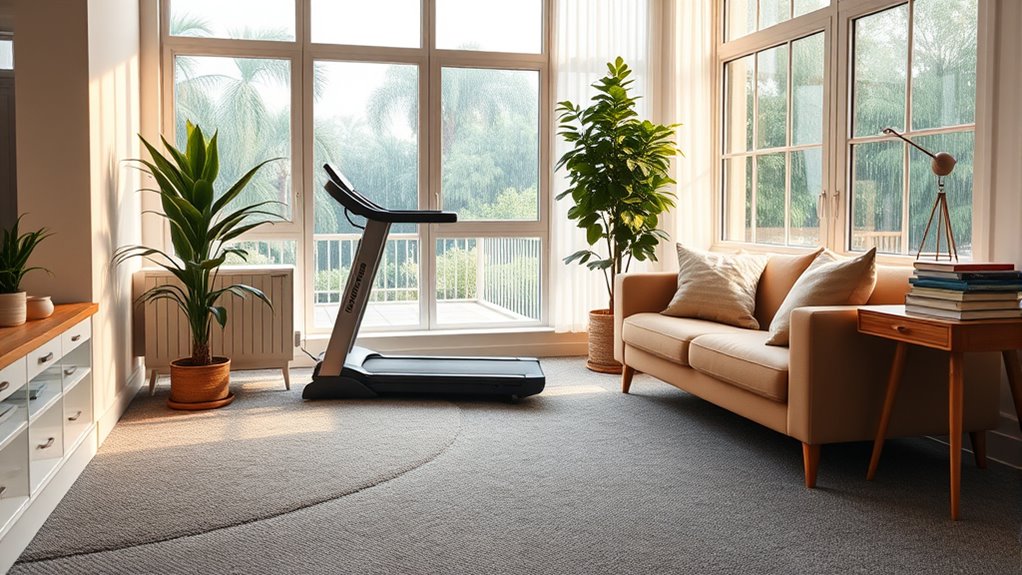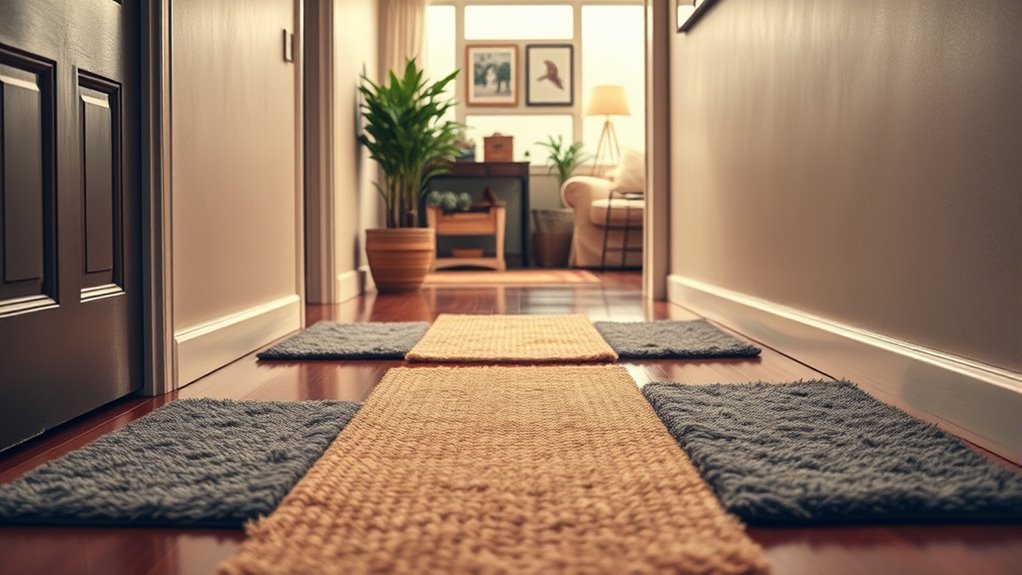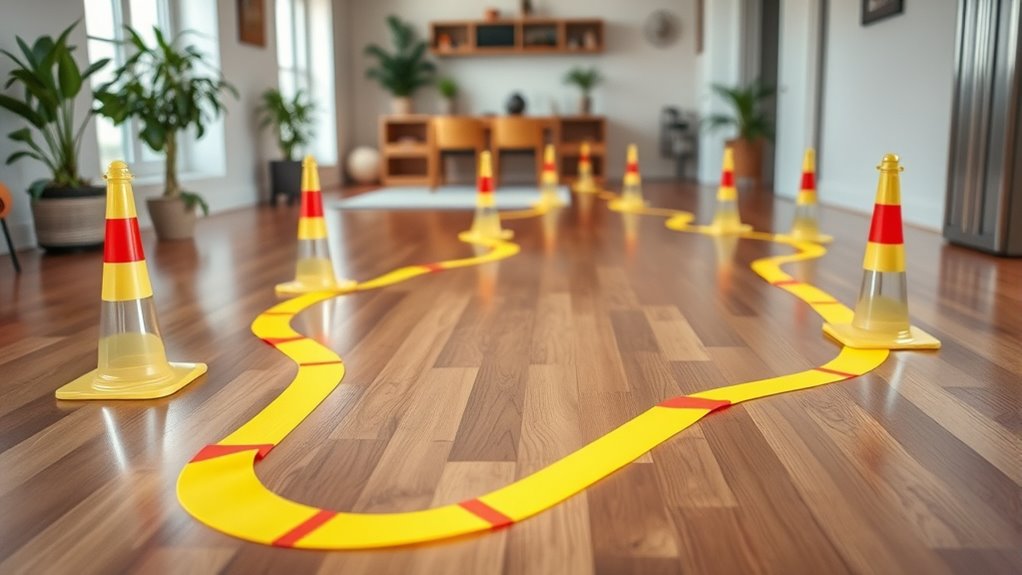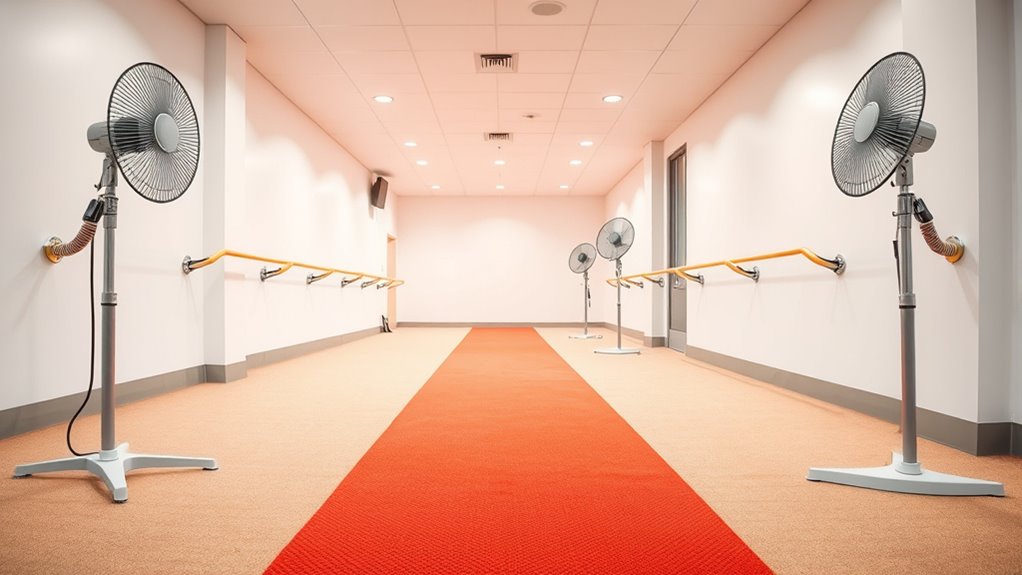To set up an indoor walking path for rainy days, choose a spacious, unobstructed area free from heavy traffic and secure the flooring with non-slip mats or textured coatings for safety. Plan your route with clear boundaries, visual cues, and decorative elements to keep it engaging. Add safety rails, supportive shoes, good lighting, and ventilation for comfort. Keep the space maintained and explore more ideas to create an enjoyable, safe indoor walking space you’ll want to use daily.
Key Takeaways
- Choose a spacious, unobstructed area and install non-slip mats or textured coatings for safety.
- Design clear boundaries and visual cues, such as painted lines or colorful borders, to organize the walking route.
- Incorporate safety features like supportive footwear, safety rails, and regular surface inspections for secure walking.
- Enhance ambiance with proper lighting, ventilation, and decorative elements to create an inviting environment.
- Track progress with motivation tools, use vibrant color schemes, and ensure device security for sustained activity.
Choosing the Right Space in Your Home

When selecting a space in your home for an indoor walking path, it’s important to prioritize areas that are spacious, unobstructed, and free from heavy foot traffic. Focus on optimizing your space by carefully arranging furniture to maximize open areas. Move bulky pieces away from the main walking route to create a clear, safe path. Consider underused corners or hallways that can be repurposed for walking without clutter. Effective furniture arrangement enhances space optimization, making the path feel natural and accessible. Additionally, choosing surfaces with appropriate traction and comfort can help prevent slips and ensure a pleasant walking experience. Avoid tight corners or narrow hallways that limit movement. By thoughtfully choosing and organizing your space, you’ll ensure a comfortable and safe environment for daily walks, even during rainy days. Proper planning sets the foundation for a functional indoor walking path.
Planning Your Indoor Track Layout

To create an effective indoor walking track, start by mapping out a clear layout that fits your available space. Consider the flow of movement, avoiding sharp turns or narrow spots that can cause congestion. Use decorative lighting to brighten the path and make it inviting, especially in darker areas. Incorporate scent diffusers along the route to enhance the atmosphere, making your walking experience more enjoyable and relaxing. Think about the placement of furniture and obstacles so they don’t interfere with your route, and keep enough room for safe, comfortable walking. Measure your space carefully to guarantee your layout is practical and functional. Planning ahead will help you design a seamless, pleasant track that motivates you to stay active indoors during rainy days. Additionally, assessing interior design principles can help you create a more balanced and aesthetically pleasing environment for your indoor walking path.
Securing the Flooring for Safety and Comfort

Choosing the right flooring is key to keeping your indoor walking path safe and comfortable. Non-slip surfaces help prevent accidents, especially on wet days. Additionally, adding cushioning can make your walk more enjoyable and reduce strain on your joints. Incorporating powerful persuasive words into your setup can motivate consistent use of the path, enhancing overall health benefits.
Non-slip Surface Options
Ensuring your indoor walking path has a non-slip surface is essential for safety and comfort during rainy days. Non-slip mats are an easy and effective solution; they provide grip and stability, reducing the risk of slips. Place them along high-traffic areas or where moisture tends to accumulate. Textured coatings are another excellent option; they can be applied directly to existing flooring to enhance traction. These coatings create a rough surface that helps prevent slips, even when the floor is wet or damp. Combining non-slip mats with textured coatings offers a layered approach to safety, ensuring your walking path remains secure. Always choose products designed for indoor use and verify they are suitable for your flooring type to maximize safety and durability. Resources and Tools can provide additional guidance on selecting the best safety solutions for your space.
Cushioning for Comfort
Adding cushioning to your indoor walking path enhances comfort and reduces fatigue, making your walks more enjoyable. Use cushioning materials like foam padding to soften the surface and provide support for your joints. Foam padding is lightweight, easy to install, and absorbs impact, preventing discomfort over extended periods. You can place foam mats directly on the floor or layer them beneath a top surface for added comfort. Choose high-density foam padding for durability and better shock absorption. Proper cushioning helps prevent injuries caused by hard surfaces and makes your walking experience more pleasant. Regularly inspect and replace worn-out foam padding to maintain ideal comfort and safety. Being aware of security concerns may also help you choose the safest materials and installation methods. With the right cushioning materials, your indoor walking path becomes a more inviting space for rainy day exercise.
Setting Up Clear Boundaries and Markers

To create a safe and effective indoor walking path, it’s essential to set up clear boundaries and markers that define your route. Use decorative borders to visually distinguish the walking area from furniture or obstacles, making it easy to stay on track. Color coding is a practical way to organize different sections or difficulty levels; for example, green for beginner zones and red for more challenging areas. Clearly mark intersections or turns with tape or painted lines, ensuring they stand out. These visual cues help prevent accidents and keep your walk organized. By combining decorative borders with strategic color coding, you create an inviting and functional space that motivates you to stay active, even when weather keeps you indoors.
Incorporating Entertainment and Motivation

To keep your indoor walks engaging, consider adding fun activity ideas or challenges along the path. Playing lively music or listening to podcasts can boost your motivation and make the time fly by. Incorporating visual stimulation, like colorful decorations or scenic images, helps maintain your interest throughout your workout. Paying attention to visual design principles ensures that your decorations and images are both attractive and effective in keeping your space lively.
Fun Activity Ideas
When it’s pouring outside, turning your indoor walking session into a fun and engaging activity can make all the difference in staying motivated. You can simulate outdoor activities by setting mini challenges or creating themed walks, like “nature strolls” or “museum tours.” Incorporate gardening tips by imagining you’re tending to a virtual garden along your path, visualizing planting flowers or trimming bushes. Use small props like plastic flowers or garden tools to make it more interactive. Adding fun elements like mini scavenger hunts or tracking your steps and milestones keeps you motivated. These activities not only break the monotony but also make your indoor walking more enjoyable, helping you stay active regardless of weather conditions. Maximize space and organization can also help create a clutter-free environment that makes moving around easier and more enjoyable.
Music and Podcasts
Listening to music or podcasts can turn your indoor walking sessions into more enjoyable experiences. Choosing the right music selection can boost your motivation and energy, making your walk feel less like exercise and more like entertainment. Opt for upbeat tunes or your favorite playlist to keep your pace steady. Podcasts also offer a great way to stay engaged; pick topics that interest you, such as storytelling, health, or current events. Well-chosen podcast topics can distract you from fatigue and help pass the time quickly. Make sure your devices are set up with easy access, so you can switch songs or episodes without interruption. With the right entertainment, your indoor walks will become something you look forward to, even on rainy days. Additionally, selecting safe and secure devices is important to protect your personal data while enjoying your entertainment.
Visual Stimulation
Adding visual stimulation to your indoor walking routine can substantially boost your motivation and enjoyment. Use visual cues, such as colorful wall art or motivational posters, to create an engaging environment. Incorporate vibrant color schemes to energize your space, making each walk more appealing. Bright, contrasting colors can help you track your progress and maintain focus, while soothing hues promote relaxation during longer sessions. Consider adding visual markers along your path, like painted footprints or themed decorations, to give you clear targets to reach. These visual cues not only enhance the aesthetic but also serve as motivational tools, encouraging you to keep moving. With thoughtfully chosen color schemes and visual cues, your indoor walking path becomes a stimulating and enjoyable activity, even on the rainiest days. Utilizing layering textures and colors can further enrich the space, making your walking experience more cozy and inviting.
Ensuring Proper Lighting and Ventilation

Good lighting and fresh air are crucial for creating a safe and inviting indoor walking path, especially on rainy days. Proper lighting design guarantees even illumination, reducing shadows and glare that can cause trips. Incorporate bright, energy-efficient LED lights positioned along the path’s length. Ventilation systems keep the air fresh and prevent stuffiness, which is indispensable for comfort and safety. Imagine this setup:
| Lighting Design | Ventilation Systems |
|---|---|
| Bright overhead LEDs, evenly spaced | Exhaust fans and air purifiers |
| Warm, glare-free wall sconces | Fresh air intake vents |
| Adjustable lighting for different needs | Continuous airflow for freshness |
This combination ensures your indoor walking space stays well-lit and well-ventilated at all times. Additionally, many explorers highlight the importance of resilience in navigating challenges, which can be metaphorically applied to maintaining a safe and comfortable indoor environment.
Adding Supportive Accessories and Equipment

To maximize safety and comfort on your indoor walking path, incorporating supportive accessories and equipment is key. Supportive footwear helps prevent slips and provides proper arch support, reducing fatigue during longer walks. Make sure your shoes have good grip and cushioning. Safety rails are also essential, especially if you have balance concerns or are new to indoor walking. Install sturdy rails along the sides of your path to offer stability and support, reducing the risk of falls. Consider adding non-slip mats in high-traffic areas to enhance traction. These accessories not only promote safety but also make your walking experience more comfortable. With supportive footwear and well-placed safety rails, you’ll create a secure environment perfect for rainy days.
Maintaining Your Indoor Walking Path for Longevity

Regular maintenance is essential to keep your indoor walking path safe and in good condition over time. To guarantee its longevity, consider these steps:
Maintaining your indoor walking path ensures safety and longevity over time.
- Regularly inspect the surface for wear or damage and address issues promptly.
- Keep the area clean to prevent dust and debris from causing slips or damage.
- Rotate different sections of your path to promote exercise variety and avoid overuse.
- Track your progress by noting improvements in speed, endurance, or distance, motivating you to stay consistent.
Frequently Asked Questions
How Can I Prevent Slipping on Indoor Flooring During Walks?
To prevent slipping on indoor flooring during walks, you should focus on improving traction. Use non-slip mats in high-traffic areas to provide extra grip and reduce the risk of falls. Additionally, wear footwear with good grip to enhance stability. Regularly check and clean your floors to remove dust or spills that could cause slipping. These simple steps will keep your indoor walks safe and enjoyable.
What Are the Best Ways to Track Progress on My Indoor Walking Path?
Imagine your progress as a story waiting to be told. To track your indoor walking, use fitness trackers for real-time data and set goals. Combine that with journaling methods to reflect on your improvements and challenges. This dual approach keeps you motivated and shows your journey’s progress clearly. You’ll turn every step into a chapter of your fitness story, making progress both measurable and meaningful.
How Do I Adapt My Indoor Route for Different Fitness Levels?
You can modify your indoor route for different fitness levels by adjusting the incline and incorporating pace variations. For beginners, keep the incline low and walk at a steady pace. As you progress, increase the incline or add intervals of faster walking to challenge yourself. This flexibility helps you stay motivated and ensures your workout remains effective, no matter your fitness level.
Can I Incorporate Stretching Areas Into My Indoor Walking Space?
Think of your indoor walking space as a garden of movement. You can definitely incorporate stretching zones and flexibility stations, turning your path into a dynamic oasis. Place mats or designated corners for stretching, making it easy to pause and limber up. This way, your route becomes more than just walking—it’s a holistic space that nurtures your flexibility and keeps your body energized on rainy days.
What Are Some Cost-Effective Options for Creating an Indoor Walking Path?
To create a cost-effective indoor walking path, consider DIY decor ideas to personalize your space without spending much. Use budget flooring options like foam tiles or peel-and-stick vinyl to keep costs low while ensuring comfort. You can also repurpose items like rugs or painted tape to define your path. This approach keeps your setup affordable yet functional, making it easy to stay active indoors during rainy days.
Conclusion
Think of your indoor walking path as a personal oasis—a sanctuary where you can escape the rain and stay active. Keep it well-maintained, inviting, and safe, so it becomes a reliable haven whenever the weather turns gloomy. With a little planning and care, your indoor track will be your steadfast companion, guiding you through stormy days and bringing sunshine to your fitness routine. Make it your dedicated space to walk, reflect, and stay energized—rain or shine.









